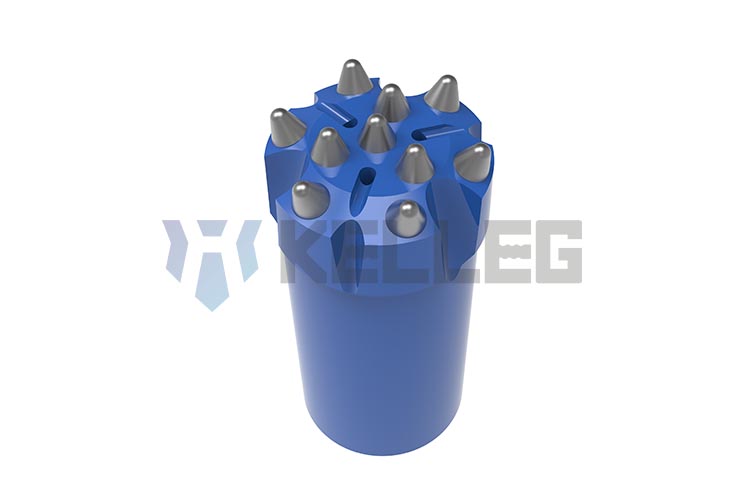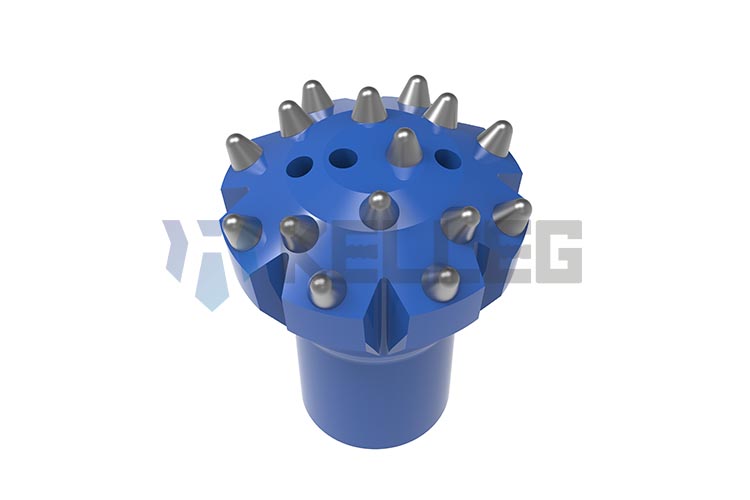2020 官网升级中!现在您访问官网的浏览器设备分辨率宽度低于1280px请使用高分辨率宽度访问。
In recent years, the button series drill bit has developed rapidly, because it has the characteristics of fast drilling speed compared with the traditional chip drill bit. What is the button bit?

The button bit is just like its name, its working surface is a spherical metal, and it is distributed on the entire surface of the bit like human teeth. From this, we can define the button bit. The button bit of the rock drilling tool is composed of a tungsten carbide button inlaid on the bit body. So the question is, how are the tungsten carbide button embedded in the drill bit body, how are they fixed on it? That’s what we’re going to share with you today.

To understand the fixing process of the button bit, we need to first understand what the fixing process of the button bit is. In fact, through the above questions, we can know that the fixation of the button bit refers to how to fix the rock-drilling tungsten carbide button on the bit body so that it can play a supporting role to ensure that the carbide buttons won’t shift and fall off during the process of drilling the rock layer and fail.
After understanding the fixation of the button drill bit, let’s enter the text to see what the fixing process of the button bit is.
There are generally three processes for the fixing process of the button bit: welding, cold inserting, and hot inserting.
1. Welding: This is the earliest used fixing process. It is relatively simple, mainly determining the size of the perforation and the alloy button through the welding gap. According to the structure form of the drill bit, the corresponding perforation is drilled on the drill bit body, and then the alloy button is welded to the drill bit body by brazing or silver welding. At present, this process does not require high drilling accuracy and button size.
The disadvantages of this process are below:
A. Relatively difficult operation/The operation is relatively difficult.
B. Easily leave welding scars/It is easy to leave welding scars.
C. Prone to lack of welding, weak welding strength.
D. Shorter service life of drill bit.
E. It is mostly used in the production of taper holes to connect small-diameter button bits, which have now been phased out.
2. Cold insert: This process is currently adopted by most enterprises. The main point of the process is to calculate the matching gap between the perforation and the alloy column according to the yield limit of the steel used for the drill bit body and use the method of interference fit to press the button into the perforation by an external force.
The characteristic of this process is below:
A. The process is easy to master and the production efficiency is relatively high, but the stability is lacking.
B. When the alloy button is pressed into the perforation, the bit body and the button are easy to be damaged under the action of external force, and the button bit life is limited.
C. It is easy to insert detached from the slot and insert shattered after a period of use.
D. It is mainly used to fix threaded button bits which are not required or repeated grinding now.
3. Hot insert: The hot insert process is mainly used for the threaded button bit with higher requirements. Select the alloy steel with good thermal expansion and toughness as the steel for the drill bit body. According to the difference in thermal expansion between the steel body and the alloy button under the same heating conditions, it is easy to select the appropriate amount of interference. The alloy button is inserted into the perforation of the drill bit body, and the fixing process is completed after the steel body shrinks at room temperature after cooling. The hot insert fixing process is not only easy to operate but also has better stability because the force on the alloy button and the bit shell is very small during the fixing process, and it is not damaged.
Through the above introduction, you may not have a big concept of the fixing process of the button bit. The button bit for impact rock drilling evolved from the large-diameter button wheel bit. Medium and large diameter button bits are new products that were gradually developed and matured in the 1970s at home and abroad. Its fixing process, like some famous drilling tool companies, all use the “hot-clamping button” or “hot-pressing-fixing button “, and the former Soviet Union adopts the “welding fixing button”, but the details of the process are unknown. We can learn about different button fixing processes through the application of small and medium diameter button bits and medium and large diameter button bits.
1. Submerged bottom induction brazing fixing button of small and medium diameter button bits
The submerged bottom induction brazing button fixing process is to ensure the welding quality, using the favorable conditions of perforation and capillary brazing, the groove bottom plate brazing method of the flake alloy drill bit has been evolved into the submerged bottom type of the button bit. Brazing button bits in this way is even more successful than brazing sheet-alloy bits.
Features:
A. The fixed button is firm. Soldering liquid fully diffuses under anaerobic conditions, which can form dense, uniform, and plump weeds;
B. The stress state of the alloy and steel body is good. The alloy cylinder only bears the small radial and tangential compressive stress generated by the condensation and shrinkage of the solder liquid, and there is no axial tensile and compressive stress. However, the cold-pressed button has huge radial, tangential, and axial stress states, and their distribution is uneven.
C. The properties of the alloy are unaffected.
D. Convenient operation, good quality stability, and high production efficiency.
E. It is easy to promote and has a quick effect.
2. Hot-clamping button for medium and large diameter button bits
For medium and large diameter button bits, Compared with the use of submerged bottom induction brazing fixing buttons, hot-clamping fixing technology has more advantages. Threaded medium and large diameter button bits are mainly used for heavy-duty rock drilling rigs to drill deep holes in hard and brittle or medium-hard rock layers. In this case, the button diameter is larger, the button pitch is larger, the steel body of the button wall is thicker, the button distribution is easier, the slag discharge condition is better, the abrasion of the steel body and the button is slower, and the button regrinding condition is better.
The advantages of the hot-clamping fixing technology:
A. The quality of the fixed button is better, and the phenomenon of a broken button is less likely to occur.
B. It eliminates the threat of the button surface being oxidized and subjected to excessive thermal stress or mechanical force that may be generated by the alloy button in other fixing methods.
C. It can calmly implement the best heat treatment specifications for the steel body and give full play to the use potential of the steel.
D. There is no flux flowing, and the appearance quality of the drill bit is good.
Disadvantages: Machining, heat treatment, testing, and gear matching processes are complex, the requirement is stricter, the quality of fixed buttons is not stable and the production efficiency is low.
Therefore, combining these two types, we can see that it will be the complementary development of the two processes in the future for a long period. We can choose one or both of them reasonably according to rock drilling conditions, drill bit diameter, equipment conditions, management level, and achievable benefit level. As for the cold-pressed button-fixing process, it will be mainly used for large-diameter DTH drill bits and roller cone drill bits with large button pitches and inconvenient heating.
I believe that through today’s sharing, everyone has a detailed understanding of the fixing process of the button bit, no matter which fixing process is selected, it needs to be carried out according to the actual situation. Only in this way, can enterprises not only produce high-quality products but also obtain excellent economic benefits.